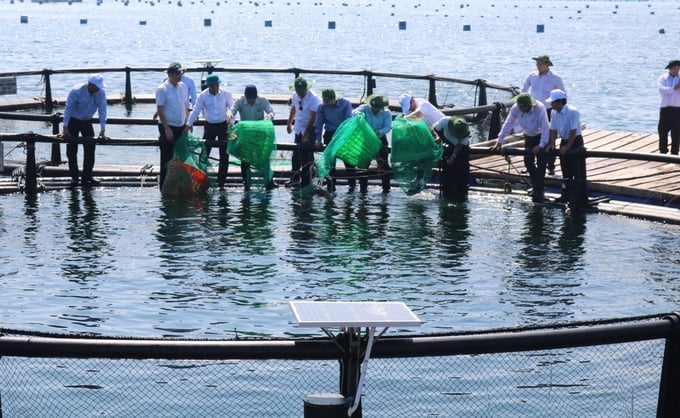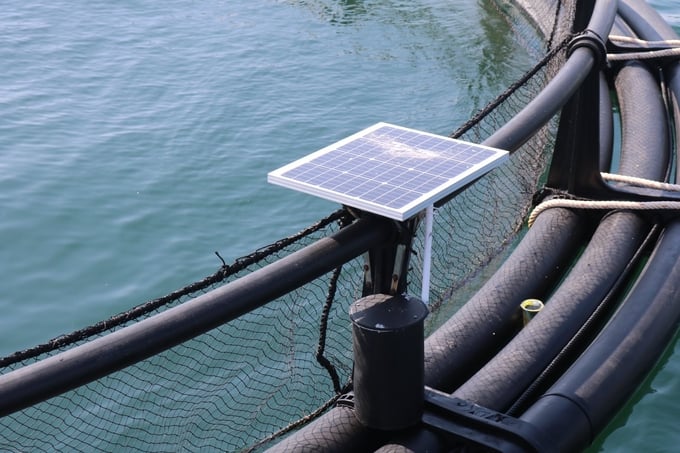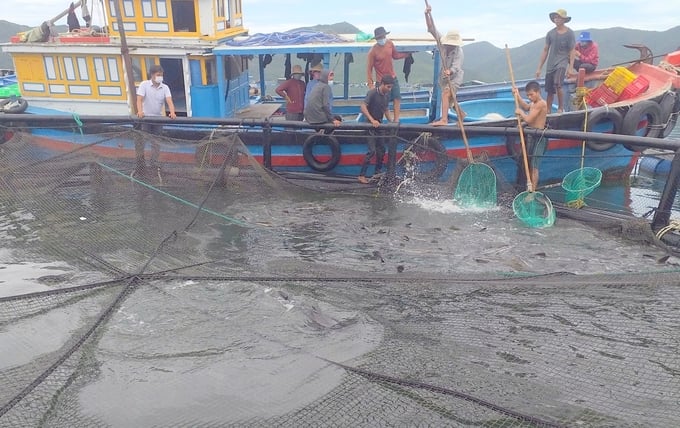May 30, 2025 | 20:21 GMT +7
May 30, 2025 | 20:21 GMT +7
Hotline: 0913.378.918
May 30, 2025 | 20:21 GMT +7
Hotline: 0913.378.918

Khanh Hoa is taking action to help farmers convert to using HDPE cages for farming. Photo: Kim So.
In order to successfully convert traditional marine farming into industrial marine farming, the industry needs to gather resolve and step up through firm actions. Accordingly, there are 5 solutions to help marine farmers understand the benefits and importance of changing the traditional marine farming model.
First of all, we need to strengthen communication so farmers can realize how changing the marine farming model can benefit them. Some examples include reducing economic losses when there are big waves or storms coming and destroying cages; gaining access to advanced farming technologies and methods of the region and the world; enjoying the State's support policies on marine farming development (allocated water surfaces, issued farming area code, damage support, debt extension when risks and unusual incidents occur during the farming process); facilitating product consumption through local trade promotion channels.

HDPE cages are durable and adaptable to natural disasters. Photo: Kim So.
Secondly, the industry must change the mindset of marine farmers through guidance and training, helping them learn more about modern marine farming models with better protection for the marine environment. Marine farmers normally think about productivity and high output. When changing their mindset to a more proactive approach, producing what the market needs, not producing what they have, marine farmers will not face risks in terms of output and be more involved in the value chain.
Thirdly, there should be policies to support the development of farming at sea, encourage the conversion of traditional marine aquaculture models using cages and rafts to new, high-tech marine farming models (HDPE cages integrating other technologies) with credit support associated with loan insurance.
It is possible to apply a credit investment model, including marine farmers contributing a portion of capital (20 - 30%) from the traditional reused cage system into the new model. The local social policy bank can offer support in the form of preferential loans with low interest rates, especially in the first 3 years, with a ratio of 30 - 40% of capital in the new investment model. Businesses using the water surface for other purposes support marine farmers with 30 - 40% of capital. The allocation period for land and water surface can be up to 20 - 30 years.

The cage is equipped with a solar-powered camera, helping farmers observe the farming process without being on the raft. Photo: Kim So.
Local authorities can also consider integrating the policy to support trade promotion of marine products (fresh or processed) in the Trade Promotion Program, expanding local consumption markets for aquatic products. The state budget supports investment in building essential infrastructure in concentrated marine farming areas, including service ports, technical infrastructure and equipment; buoy systems and boundary lights; environmental monitoring systems in concentrated farming areas; research, transfer and application of high technology in the marine farming chain; human resources training in service of the industry.
Fourthly, we need better scientific and technological solutions. They must be specifically quantified by reducing labor, increasing animal survival rate, and showing economical efficiency compared to traditional marine farming models. Only then will marine farmers be able to follow the transition voluntarily. In order to realize this vision, it is necessary to have policies to support implementation, including testing and evaluating the effectiveness of new cage models in marine farming areas, which will serve as a basis for developing national technical regulations and standards on cage and raft systems.
The industry should encourage farmers to replicate successful examples of industrial marine farming models, build advanced farming models for a number of objects with high economic value combined with seaweed cultivation, promote industrial services in marine farming, and apply 4.0 technology in management.

Small size cage is suitable for household-scale production, making it easy for farmers to harvest fish. Photo: Kim So.
Fifthly, it is necessary to manage and reorganize production in a modern, synchronous and sustainable direction with outstanding, unique, and highly competitive products. Special attention is required to management forms that include community participation and encourage the establishment of cooperative and collaborative group models. Marine farming cooperatives should be based on reorganizing small and scattered farming facilities to save production costs and better protect the environment.
Translated by Samuel Pham

(VAN) Several scientists and farmers are experimenting with soil treatment in some key durian-growing regions such as Cai Lay (Tien Giang), Dak Song, Gia Nghia, and Dak R’lap (Dak Nong).
/2025/05/25/4127-3-073637_820.jpg)
(VAN) Thanks to the promotion from an FAO-implemented project, vegetable production in greenhouses in Moc Chau has seen strong development, from 1.5 hectares in 2021 to nearly 50 hectares in 2024.

(VAN) FAO has recently supported USD 140,000 to implement the project 'Risk mitigation human-animal interface risks through disease control initiatives in pig farming.'

(VAN) The People's Committee of Tra Vinh province has approved an adjustment to the investment policy for the Green Hydrogen Plant project, increasing its area to approximately 52.76 hectares.
![Reducing emissions from rice fields: [2] Farmers’ commitment to the soil](https://t.ex-cdn.com/nongnghiepmoitruong.vn/608w/files/news/2025/05/05/dsc08881jpg-nongnghiep-140632.jpg)
(VAN) Clean rice cultivation model in Thuong Tan commune, Bac Tan Uyen district, is assisting local residents in achieving sustainable agriculture by substantially reducing costs, increasing productivity, and protecting the environment.

(VAN) At the conference to disseminate Resolution No. 68, AgriS introduced its digital agricultural ecosystem and reaffirmed its commitment to accompanying the Government in promoting private sector development and sustainable agriculture.

(VAN) 'Blue Ocean - Blue Foods' initiative is designed to restore marine ecosystems and establish sustainable livelihoods for local communities by cultivating a minimum of 1,000 hectares of cottonii seaweed in the first three years.